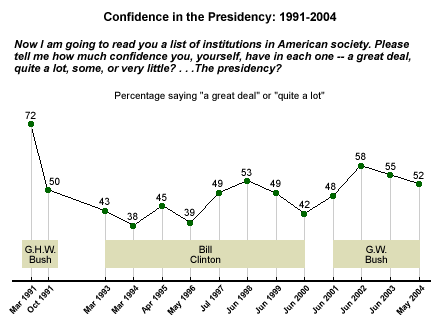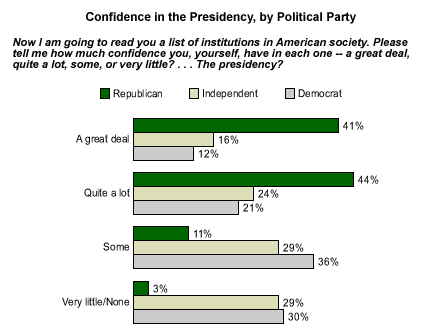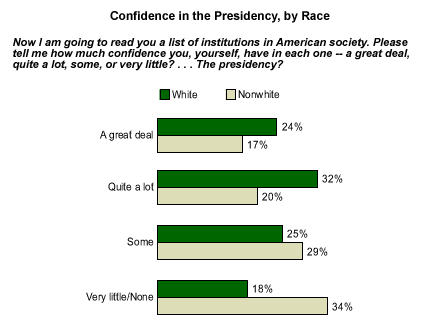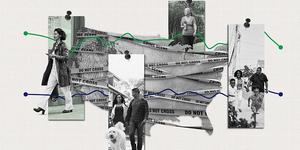Recent polls may show flagging job approval and favorability ratings for George W. Bush, but Americans continue to express significant confidence in the institution of the presidency in general. Gallup's May 2004 "confidence in institutions" survey* shows that 52% of the public expresses either "a great deal" or "a fair amount" of confidence in the presidency, placing it in the top third of the list of 15 institutions tested. Other institutions receiving similar ratings include banks (53%), organized religion (53%), and the Supreme Court (46%). The military tops the list, with 75% of Americans saying they have a great deal or fair amount of confidence in that institution, while health maintenance organizations (HMOs) are at the bottom, with a confidence rating of just 18%.
Trends From Three Presidencies
Gallup's trend on confidence in the presidency spans three presidential administrations, each with its own unique story to tell. The question was first asked in March 1991, when George H.W. Bush was riding a job approval rating in the mid-80% range in the afterglow of the Persian Gulf War. Not surprisingly, the institution of the presidency scored a high in public confidence that has yet to be equaled, or even approached: 72%. By the time the question was asked again in October 1991, Bush's approval rating had dropped to the 60% range, and confidence in the presidency tumbled along with it, to 50%.
Shortly after Bill Clinton took office in 1993, 43% of Americans expressed confidence in the presidency. That dipped to 38% in March 1994, the lowest measurement in the 13-year trend line on this question. Confidence averaged 45% while Clinton was in office. Ironically, the three highest levels of confidence during Clinton's presidency were recorded between 1997 and 1999, when an independent-counsel investigation led to impeachment proceedings against Clinton. As the impeachment controversy subsided toward the end of Clinton's tenure, Americans' confidence in the office dropped seven points to a level more typical of his presidency.

The ups and downs of George W. Bush's term in the White House are reflected in the most recent four measurements of confidence in the presidency. The 10-point jump in confidence from June 2001 to June 2002 can be attributed to the rally effect that appeared in many polls the year following the Sept. 11 terrorist attacks. The rally effect was still evident in mid-2002, though not as strongly as in the fall of the previous year. The 2003 and 2004 polls show a steady tapering of public confidence in the institution. The current 52% of Americans who say they have a great deal or quite a lot of confidence in the presidency is in line with the average of all the results recorded for this question since 1991.
Who Is Most Confident?
The most recent survey reveals that, politically, ratings of confidence in the presidency as an institution break down similarly to ratings of Bush himself. With a Republican in office, Democrats are the least likely to express confidence in the institution, at 33%. The majority of Republicans (85%) are confident in the presidency.

Likelihood to be confident in the presidency also differs significantly along racial lines. Just as nonwhites are less likely than whites to approve of the way Bush is handling his job as president, they are also less likely to say they have confidence in the office itself. Just 37% of nonwhites express confidence in the presidency, compared with 56% of whites.

Bottom Line
Confidence in the presidency is a significant political barometer. It can shift (albeit not as dramatically) along the same lines as a president's job approval rating, and it can be affected by the country's prevailing news and political climate.
*These results are based on telephone interviews with a randomly selected national sample of 1,002 adults, aged 18 and older, conducted May 21-23, 2004. For results based on this sample, one can say with 95% confidence that the maximum error attributable to sampling and other random effects is ±3 percentage points. In addition to sampling error, question wording and practical difficulties in conducting surveys can introduce error or bias into the findings of public opinion polls.
